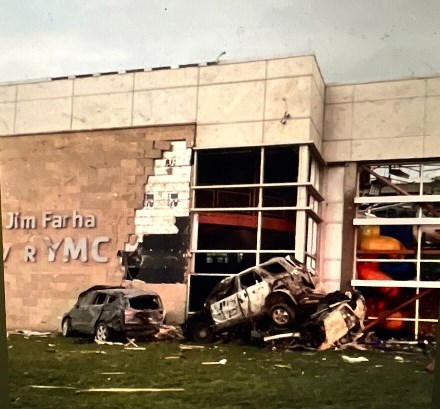Despite extensive damage to several neighborhoods, authorities say only four people were injured in Friday night’s storm.

by Tom Shine, KMUW and Kansas News Service
Wichita — Officials are continuing to assess the damage caused by a tornado Friday night that hit southeast Wichita and Andover.
Andover Fire Chief Chad Russell said Saturday that four people suffered minor injuries in the storm. He said no people remain unaccounted for.
More than 200 emergency responders from 30 agencies were continuing to search through the debris as a cautionary move.
Andover Fire Department officials say about 1,000 buildings and homes were damaged in Sedgwick and Butler counties. It said the tornado caused damage along a six-mile path.
Russell said some neighborhoods in Andover were “damaged enough that houses were completely blown down” and cited areas that suffered “very bad damage.”
Among the buildings hit was the Andover YMCA, near Kellogg and Andover Road. YMCA officials said the building “suffered significant damage” from the storm.
It said employees and members inside the building took shelter as the tornado approached. No one was injured.
The Andover YMCA remains closed until further notice.
Prairie Creek Elementary School, which is just south of the YMCA, also was damaged by the tornado. District officials planned to assess the damage Saturday.
Andover’s City Hall, near Central and Andover Road, also suffered damage.
Officials set up an emergency shelter at St. Vincent de Paul Catholic Church in Andover. Russell said no one used the shelter Friday night.
Ironically, St. Vincent was destroyed in the April 1991 tornado that struck Andover. That storm killed 21 people in Wichita and Andover.
The Kansas Department of Transportation said parts of U.S. 54-400 remain closed between 159th Street to Santa Fe Lake Road. Crews are trying to clear the road of downed power lines.
More than 15,000 people were without power after the storm Friday night. Westar said that power had been restored to all but 1,200 customers.
Russell, the fire chief, asked people to continue to avoid the area so emergency crews can complete their assessment. He said city officials will let volunteers know when they can help with the clean up.
Officials also said private drones are banned from the area. Authorities are using a plane from the Kansas Highway Patrol and drones from the Andover Police Department to survey the damage.
The United Way of the Plains is coordinating donations for a relief fund. People can donate at unitedwayplains.org.
The Kansas News Service is a collaboration of KCUR, Kansas Public Radio, KMUW and High Plains Public Radio focused on health, the social determinants of health and their connection to public policy.
Kansas News Service stories and photos may be republished by news media at no cost with proper attribution and a link to ksnewsservice.org.
See more at https://www.kmuw.org/2022-04-30/officials-assessing-damage-from-tornado-that-hit-wichita-andover
